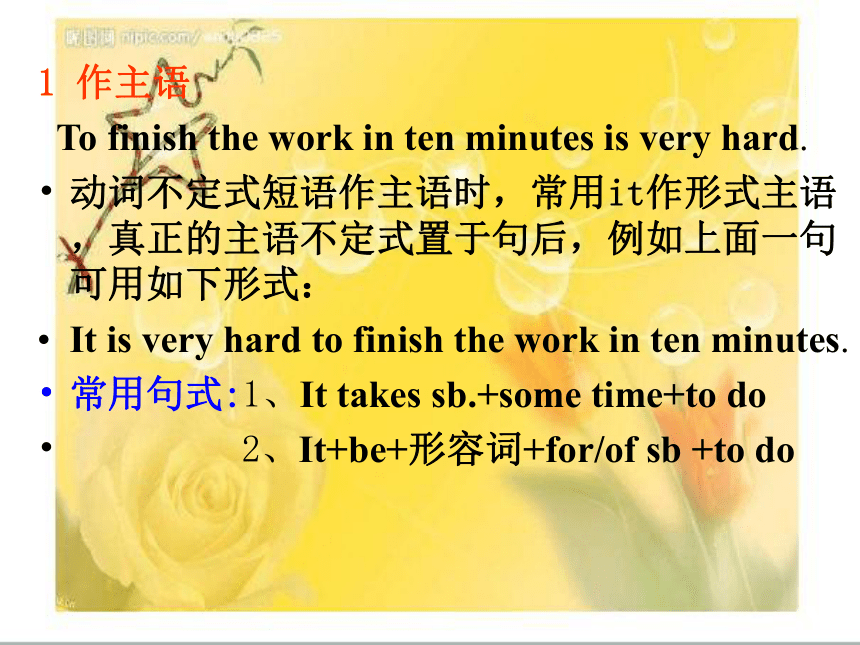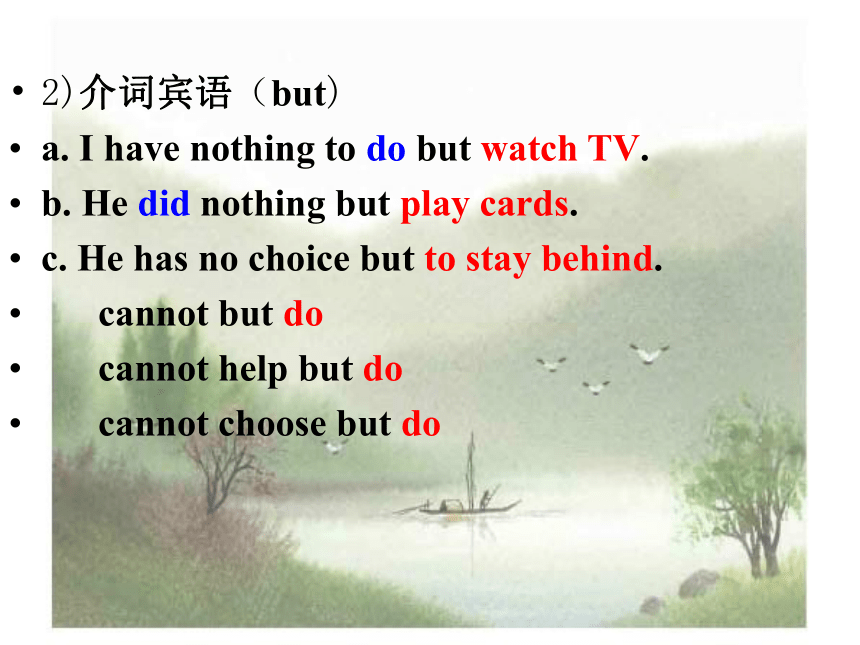【备战2014,教师原创】2014年高考英语语法备考 动词不定式 课件
文档属性
| 名称 | 【备战2014,教师原创】2014年高考英语语法备考 动词不定式 课件 |  | |
| 格式 | zip | ||
| 文件大小 | 9.8MB | ||
| 资源类型 | 教案 | ||
| 版本资源 | |||
| 科目 | 英语 | ||
| 更新时间 | 2014-03-24 19:41:52 | ||
图片预览









文档简介
课件26张PPT。非谓语动词形式:它有三种形式:不定式(to do),分词(现在分词doing、过去分词done),动名词 (doing)
定义:在句子中不是谓语动词叫做非谓语动词..在句中可起名词,形容词,副词的作用,在句中充当主语,宾语,表语,补语,定语或状语.即动词的非谓语形式除了不能独立作谓语外,可以承担句子的任何成分非谓语动词(非限定动词)
非谓语动词特征:
1)无人称和数的变化。
2)不失去原意,可以加上自己的宾语或状语,构成非谓语动词短语。
3)否定式不用借助于助动词在谓语动词前加not
另外还有一些非动词的特征,相当于名词、形容词等,在句子里可以作这些词类所能用作的句子成分非谓语动词在句中不能单独作谓语动词。不受主语的人称和数的限制。
动词不定式的基本形式 一般式:to do(表一般性的动作) 被动式 to be done
进行式:to be doing(表动作正在进行) 被动式 to be being done
完成式:to have done(表动作在谓语动词之前发生) 被动式 to have been done
1 作主语
To finish the work in ten minutes is very hard.
动词不定式短语作主语时,常用it作形式主语,真正的主语不定式置于句后,例如上面一句可用如下形式:
It is very hard to finish the work in ten minutes.
常用句式:1、It takes sb.+some time+to do
2、It+be+形容词+for/of sb +to do
2.作表语但是:a. What I can do everyday is (to)study hard.His wish is to be a doctor.My job is to teach English. b.be to seek,be to let,be to blame3.作宾语1)动词宾语
A.V1+to+V2
a.He wishes to go abroad
b.We have decided to give them a hand.
c.I want to watch TV.
常与不定式做宾语连用的动词有:want, hope, wish, offer, fail, plan, learn, pretend, refuse, manage, help, agree, promise, prefer, B该题考查疑问词+不定式在句中做宾语的用法。英语中有一些动词 后可以跟一个疑问词的不定式做宾语,如:tell, discuss, know, show, learn, decide, wonder, explain…B.v+wh-+to do2)介词宾语(but)
a. I have nothing to do but watch TV.
b. He did nothing but play cards.
c. He has no choice but to stay behind.
cannot but do
cannot help but do
cannot choose but do
3)v+it+o.c+to do
动词不定式作宾语,后面有宾语补足语的时候必须用it做宾语,将真正的宾语放在后面。
a. He thinks it important to work hard
b. I consider it necessary to clean our classroom every day.4.作定语
a.Manager,do you have anything to be typed ?
b.As a typist ,do you have anything to type now ?
c.I am free now .Do you have anything to type ?
d.Please give me an apple to eat .
e.They will make some candles to give light.
f.Have you anything to send?(自己寄)
g.Have you anything to be sent?( 别人寄)
其它的情况:
1)如果是序数词或者中心词被序数词修饰,用不定式作定语
a.I was the first woman to travel alone at the North pole.
b.Shang hai is the first city in the world to have built a high—speed maglev train.
c.He is always the first to come and the last to leave.
d.Women and children were the first to get into the lifeboats.
e.The last one to come pays the bill.2)a.They have a nice roomto live in .
They have a nice room in which to live.
b. Please give me a knife to cut with.
.Please give me a knife with which to cut.
c.I have no pen to write with.
I have no pen with which to write.
d.She is the girl to go to school with.
.Sheis the girl with whom to go to school.
大家看看这些句子有什么特点? 由此可以看出:作定语的不定式如果是不及物动词或者不定式修饰的名词/代词是不定式的地点、工具等,不定式后面必须用一个介词。3)名词是抽象名词,用不定式作定语,常见的有:ability,chance,idea,excuse,
reply,belief,reason,attempt等。
a.He has the ability to read and write.
b.I have no chance to go to college.
请大家自己想些例句。Who?
请翻译下面的句子:
a.The old man has a girl look after him.
b.The old man has a girl to look after him.
c.The old man has a girl to look after.
d.The old man has a girl to be looked after.
e.The old man has a girl looked after.(这位老人叫一个女孩照顾他)(这位老人有一个照顾他的女孩)(这位老人有一个女孩要照顾)(这位老人有一个要照顾的女孩)这位老人叫别人照顾这个女孩)5.作宾语补足语
一个动词的后面带有一个宾语意思仍然不完整时如果用动词进行补充说明就要用动词不定式(作宾语补足语)。如:
tell sb. to do sth.
ask sb. to do sth.
order sb. to do sth.
但是:“吾看三室两厅一感觉”
5看-(see,watch,observe,notice,look at)
3使-(let,make,have)
2听-(hear,listen to)
1感觉-(feel)
这些动词真奇怪,主动语态 to省去,被动语态又回来。
注意
hope (希望)
demand(要求)
后面
不能跟
动词不定
式的复合宾语。
只能说成:
wish sb. to do sth.
require sb.to do sth. ①表目的:
He worked day and night to get the money.
She sold her hair to buy the watch chain.
注意:不定式放句首时,逻辑主语与句子主语要一致(常翻译成“为了”)
wrong:To save money, every means has been tried.
right:To save money, he has tried every means. 6.作状语②表结果:
He arrived late to find the train gone.
常用only放在不定式前表示强调:
eg.a.I visited him only to find him out.
b. A few years later he came home only to find his home town changed.
c.I hurried to the post office, only to find it was closed.
③表原因:
They were very sad to hear the news.
④表程度a.It's too dark for us to see anything.
b.The question is simple for him to answer.特别补充:1.in order that.../so that...
(主句的主语和从句主语一致时......)
2.so...that.../such...that...
(主句的主语和从句主语一致时......)
3.too...to...(太......而不能......)
4.be...enough to do
请用上面的结构分别造句。
5.用在表语后面,这时如果用不定式的完成式,所表示的动作在谓语动词之前发生a.I am glad to meet you .
I am glad to have met you .
b.I am sorry to keep you waiting.
I am sorry to have kept you waiting.
c.She was happy to come yesterday.
She was happy to have come yesterday.
6.too...to...(太...而不能 ...)。但是,如果too 后面跟形容词:ready,easy,pleased,glad,willing,
eager等时,含义却相当于very(十分,非常),此时too前面常还有only/but用以加强语气。
a.I am only too glad to help others.
b.She is only too pleased to go.
never/not too...to...不太...所以能
too...not to...非常...而不会不/而能...
One is never too old to learn. 活到老学到老
She is too happy not to come.
她非常高兴而不会不来。
..7.下列常用短语用作独立成分
to be honest=honestly speaking
to be exact=exactly speaking
to be frank=frankly speaking
to tell (you) the truth
to be honest with you
to begin/start with
to make matters worse
to be brief
to make a long story short
......
8.下列单词(短语)的用法1)had better
would rather
why(not)
你能把他们所有的备考点说出来吗?
2)prefer 构成哪些短语?
3)pretend/seem/happen后面常跟怎样的动词形式?8.不定式的否定在其前面+not:.not to do/not to be done /not to have done...
9.to/in order to /so as to
10.不定式的被动式:
1)I speak loudly to be heard.
2)He felt honored to be invited.
3)The message is supposed to be sent as soon as possible.
4)The book is said to have been put into English.
5)Many raw materials are waiting to be used.
THANK YOU
定义:在句子中不是谓语动词叫做非谓语动词..在句中可起名词,形容词,副词的作用,在句中充当主语,宾语,表语,补语,定语或状语.即动词的非谓语形式除了不能独立作谓语外,可以承担句子的任何成分非谓语动词(非限定动词)
非谓语动词特征:
1)无人称和数的变化。
2)不失去原意,可以加上自己的宾语或状语,构成非谓语动词短语。
3)否定式不用借助于助动词在谓语动词前加not
另外还有一些非动词的特征,相当于名词、形容词等,在句子里可以作这些词类所能用作的句子成分非谓语动词在句中不能单独作谓语动词。不受主语的人称和数的限制。
动词不定式的基本形式 一般式:to do(表一般性的动作) 被动式 to be done
进行式:to be doing(表动作正在进行) 被动式 to be being done
完成式:to have done(表动作在谓语动词之前发生) 被动式 to have been done
1 作主语
To finish the work in ten minutes is very hard.
动词不定式短语作主语时,常用it作形式主语,真正的主语不定式置于句后,例如上面一句可用如下形式:
It is very hard to finish the work in ten minutes.
常用句式:1、It takes sb.+some time+to do
2、It+be+形容词+for/of sb +to do
2.作表语但是:a. What I can do everyday is (to)study hard.His wish is to be a doctor.My job is to teach English. b.be to seek,be to let,be to blame3.作宾语1)动词宾语
A.V1+to+V2
a.He wishes to go abroad
b.We have decided to give them a hand.
c.I want to watch TV.
常与不定式做宾语连用的动词有:want, hope, wish, offer, fail, plan, learn, pretend, refuse, manage, help, agree, promise, prefer, B该题考查疑问词+不定式在句中做宾语的用法。英语中有一些动词 后可以跟一个疑问词的不定式做宾语,如:tell, discuss, know, show, learn, decide, wonder, explain…B.v+wh-+to do2)介词宾语(but)
a. I have nothing to do but watch TV.
b. He did nothing but play cards.
c. He has no choice but to stay behind.
cannot but do
cannot help but do
cannot choose but do
3)v+it+o.c+to do
动词不定式作宾语,后面有宾语补足语的时候必须用it做宾语,将真正的宾语放在后面。
a. He thinks it important to work hard
b. I consider it necessary to clean our classroom every day.4.作定语
a.Manager,do you have anything to be typed ?
b.As a typist ,do you have anything to type now ?
c.I am free now .Do you have anything to type ?
d.Please give me an apple to eat .
e.They will make some candles to give light.
f.Have you anything to send?(自己寄)
g.Have you anything to be sent?( 别人寄)
其它的情况:
1)如果是序数词或者中心词被序数词修饰,用不定式作定语
a.I was the first woman to travel alone at the North pole.
b.Shang hai is the first city in the world to have built a high—speed maglev train.
c.He is always the first to come and the last to leave.
d.Women and children were the first to get into the lifeboats.
e.The last one to come pays the bill.2)a.They have a nice roomto live in .
They have a nice room in which to live.
b. Please give me a knife to cut with.
.Please give me a knife with which to cut.
c.I have no pen to write with.
I have no pen with which to write.
d.She is the girl to go to school with.
.Sheis the girl with whom to go to school.
大家看看这些句子有什么特点? 由此可以看出:作定语的不定式如果是不及物动词或者不定式修饰的名词/代词是不定式的地点、工具等,不定式后面必须用一个介词。3)名词是抽象名词,用不定式作定语,常见的有:ability,chance,idea,excuse,
reply,belief,reason,attempt等。
a.He has the ability to read and write.
b.I have no chance to go to college.
请大家自己想些例句。Who?
请翻译下面的句子:
a.The old man has a girl look after him.
b.The old man has a girl to look after him.
c.The old man has a girl to look after.
d.The old man has a girl to be looked after.
e.The old man has a girl looked after.(这位老人叫一个女孩照顾他)(这位老人有一个照顾他的女孩)(这位老人有一个女孩要照顾)(这位老人有一个要照顾的女孩)这位老人叫别人照顾这个女孩)5.作宾语补足语
一个动词的后面带有一个宾语意思仍然不完整时如果用动词进行补充说明就要用动词不定式(作宾语补足语)。如:
tell sb. to do sth.
ask sb. to do sth.
order sb. to do sth.
但是:“吾看三室两厅一感觉”
5看-(see,watch,observe,notice,look at)
3使-(let,make,have)
2听-(hear,listen to)
1感觉-(feel)
这些动词真奇怪,主动语态 to省去,被动语态又回来。
注意
hope (希望)
demand(要求)
后面
不能跟
动词不定
式的复合宾语。
只能说成:
wish sb. to do sth.
require sb.to do sth. ①表目的:
He worked day and night to get the money.
She sold her hair to buy the watch chain.
注意:不定式放句首时,逻辑主语与句子主语要一致(常翻译成“为了”)
wrong:To save money, every means has been tried.
right:To save money, he has tried every means. 6.作状语②表结果:
He arrived late to find the train gone.
常用only放在不定式前表示强调:
eg.a.I visited him only to find him out.
b. A few years later he came home only to find his home town changed.
c.I hurried to the post office, only to find it was closed.
③表原因:
They were very sad to hear the news.
④表程度a.It's too dark for us to see anything.
b.The question is simple for him to answer.特别补充:1.in order that.../so that...
(主句的主语和从句主语一致时......)
2.so...that.../such...that...
(主句的主语和从句主语一致时......)
3.too...to...(太......而不能......)
4.be...enough to do
请用上面的结构分别造句。
5.用在表语后面,这时如果用不定式的完成式,所表示的动作在谓语动词之前发生a.I am glad to meet you .
I am glad to have met you .
b.I am sorry to keep you waiting.
I am sorry to have kept you waiting.
c.She was happy to come yesterday.
She was happy to have come yesterday.
6.too...to...(太...而不能 ...)。但是,如果too 后面跟形容词:ready,easy,pleased,glad,willing,
eager等时,含义却相当于very(十分,非常),此时too前面常还有only/but用以加强语气。
a.I am only too glad to help others.
b.She is only too pleased to go.
never/not too...to...不太...所以能
too...not to...非常...而不会不/而能...
One is never too old to learn. 活到老学到老
She is too happy not to come.
她非常高兴而不会不来。
..7.下列常用短语用作独立成分
to be honest=honestly speaking
to be exact=exactly speaking
to be frank=frankly speaking
to tell (you) the truth
to be honest with you
to begin/start with
to make matters worse
to be brief
to make a long story short
......
8.下列单词(短语)的用法1)had better
would rather
why(not)
你能把他们所有的备考点说出来吗?
2)prefer 构成哪些短语?
3)pretend/seem/happen后面常跟怎样的动词形式?8.不定式的否定在其前面+not:.not to do/not to be done /not to have done...
9.to/in order to /so as to
10.不定式的被动式:
1)I speak loudly to be heard.
2)He felt honored to be invited.
3)The message is supposed to be sent as soon as possible.
4)The book is said to have been put into English.
5)Many raw materials are waiting to be used.
THANK YOU
